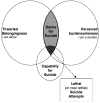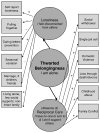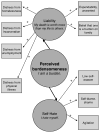The interpersonal theory of suicide
- PMID: 20438238
- PMCID: PMC3130348
- DOI: 10.1037/a0018697
The interpersonal theory of suicide
Abstract
Suicidal behavior is a major problem worldwide and, at the same time, has received relatively little empirical attention. This relative lack of empirical attention may be due in part to a relative absence of theory development regarding suicidal behavior. The current article presents the interpersonal theory of suicidal behavior. We propose that the most dangerous form of suicidal desire is caused by the simultaneous presence of two interpersonal constructs-thwarted belongingness and perceived burdensomeness (and hopelessness about these states)-and further that the capability to engage in suicidal behavior is separate from the desire to engage in suicidal behavior. According to the theory, the capability for suicidal behavior emerges, via habituation and opponent processes, in response to repeated exposure to physically painful and/or fear-inducing experiences. In the current article, the theory's hypotheses are more precisely delineated than in previous presentations (Joiner, 2005), with the aim of inviting scientific inquiry and potential falsification of the theory's hypotheses.
PsycINFO Database Record (c) 2010 APA, all rights reserved.
Figures





References
-
- Abe R, Shioiri T, Nishimura A, Nushida H, Ueno Y, Kojima M, et al. Economic slump and suicide method: preliminary study in Kobe. Psychiatry Clin Neurosci. 2004;58:213–216. - PubMed
-
- Abramson LY, Metalsky GI, Alloy LB. Hopelessness depression: A theory-based subtype of depression. Psychological Review. 1989;96:358–372.
-
- Adams DP, Barton C, Mitchell GL, Moore AL, Einagel V. Hearts and minds: suicide among United States combat troops in Vietnam, 1957–1973. Social Science and Medicine. 1998;47:1687–1694. - PubMed
-
- Ajdacic-Gross V, Wang J, Bopp M, Eich D, Rossler W, Gutzwiller F. Are seasonalities in suicide dependent on suicide methods? A reappraisal. Social Science and Medicine. 2003;57:1173–1181. - PubMed

